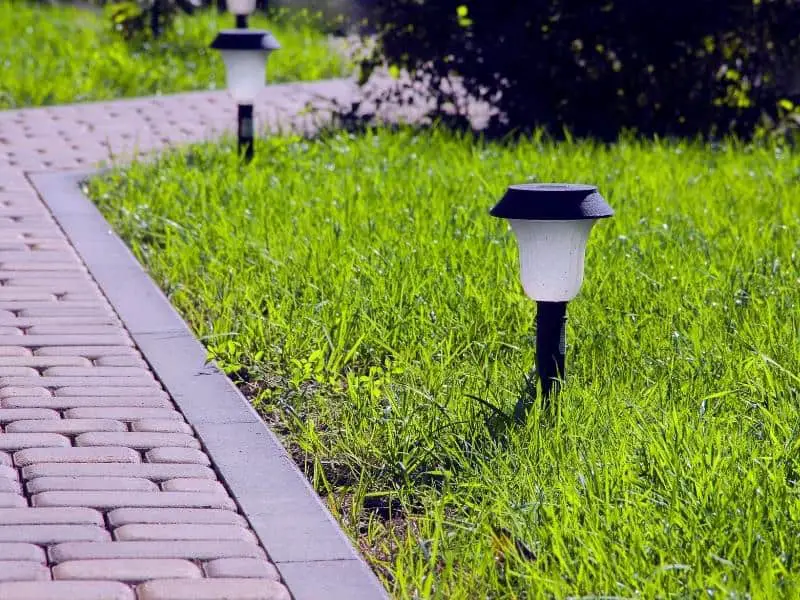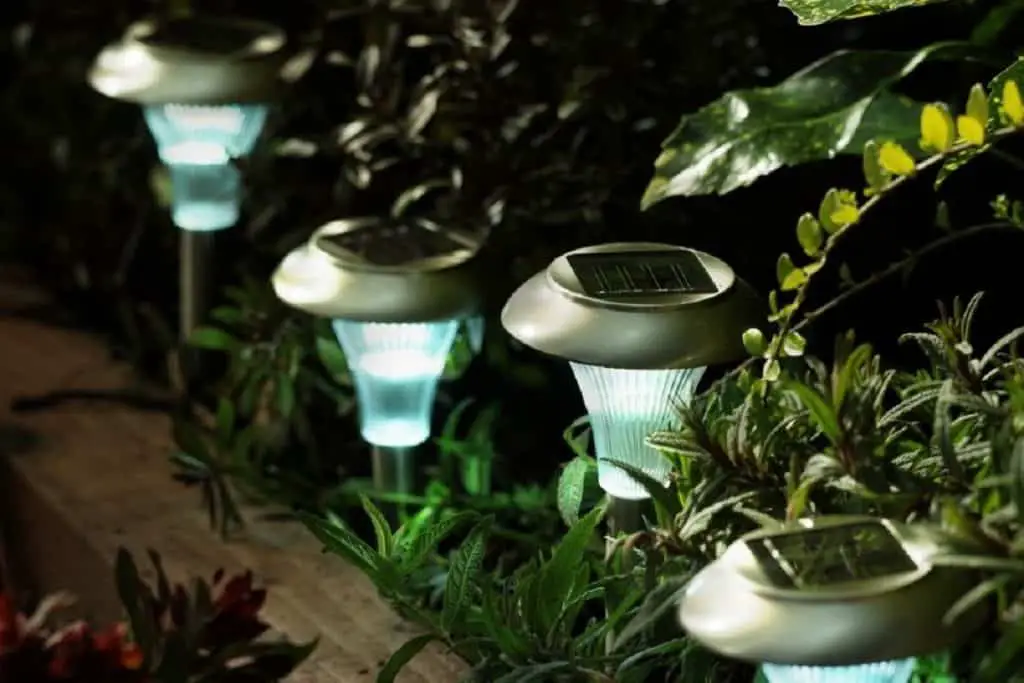Solar Panels are more correctly called Photovoltaic Cells as they will generate electrical power when light of sufficient intensity falls on them. They have been named solar panels because the sun is the most efficient source of light on our planet. Sunlight has sufficient intensity and is freely available for about half the day and most months of the year.
The solar panels that power solar lights do not need direct sunlight. Solar lights work when charged via direct sunlight and indirect sunlight caused by shadows, cloud cover, or rain. Light of the correct intensity is required to charge the batteries of a solar power light effectively.
Solar-powered lights are powered by batteries recharged when light falls on the photovoltaic cells to generate a potential difference in the batteries. A light-sensitive cell detects when it gets dark and switches the electricity supplied by the batteries to the lights on.
- How solar lights work
- What the optimal conditions for solar lights are
- What to consider when buying solar lights
Solar lights are designed to provide lighting when a certain level of darkness is reached. We will look at how the energy from any light source can be measured and how the chemical process in photovoltaic cells works.

Why Direct Sunlight Work Best For Solar Lights
The earth’s axis is tilted at 23.5 degrees in the planet’s orbital around the sun. As the earth’s position changes every day there is one optimal latitude where the sunlight falls perpendicular (or direct) on the planet’s surface.
- The term direct sunlight is used erroneously. The intensity of the sunlight reaching the earth varies greatly and depends on the latitude of each location.
During the winter months, the northern hemisphere is tilted away from the sun resulting in only low-intensity sunlight reaching the surface and atmosphere above the earth. The southern hemisphere is closest to the sun in orientation and thus experiences summer while the northern hemisphere experiences winter.
Light Intensity
The intensity of the light determines how much energy it can impart. Albert Einstein and Max Plank recognized that light acts like particles and waves. The particle has mass and momentum, and thus energy.
The particle moves like a wave at a specific frequency and thus has energy according to the formula E =hf, where h is Plank’s Constant and f is the frequency of the light.
Light is comprised of various colors of light, all at different wavelengths. Red has the lowest wavelength of all visible light and, thus the lowest energy photons. Blue or Ultraviolet light has the highest wavelength and thus also the most energetic photons.
Peak Sun Power
During the sun’s height each day, the high-energy light is abundant but as the sun dips towards the horizon, the last sunrays visible are the low-energy red light rays.
You can imagine light as little packets of energy streaming toward the earth in a wave-like path. These packets of light are called photons. The photons traveling from the sun to the earth’s surface have to travel an average distance of 93 million miles.
The photons that travel to the equator have a shorter distance than the photons traveling to the North Pole during winter.
As the photons travel, they will encounter obstacles that will absorb their energy and reduce the intensity of the light reaching the earth. The intensity of sunlight is the number of photons per square meter hitting the earth
A photovoltaic cell placed on the equator will generate more energy than a photovoltaic cell placed on the North Pole during winter.
Obstacles
Other obstacles that will reduce the intensity of the sunlight are clouds or trees that will cause shadows on the solar cells. Light can bend around obstacles in its way and can be reflected from all surfaces except for a black surface.
The shadows caused by the obstacles are thus merely areas of low light intensity.
At nighttime, the sunlight cannot reach the earth’s surface as it is the earth’s own shadow that we call night. Photovoltaic cells or solar cells can work in low light intensity levels but will not generate much power as fewer photons collide with the solar cell’s surface.
Peak Power
Solar cells generate the most power when they are oriented to receive direct sunlight during daylight hours. Some solar panels are designed to follow the sun along its trajectory through the day, just like some flowers do.
The most productive time is during the six hours per day where the sunlight is most intense.
Photovoltaic cells have been developed to generate power using the moonlight. The moon is just a mirror reflecting the sun’s rays towards earth at night. The satellites and space station solar cells also use very low-intensity light to generate power.
Solar cells need to be adjusted to allow the sunlight to fall perpendicularly onto the cell’s surface. The sun’s direct angle changes along the earth’s latitudinal lines.
Most solar installations have a winter angle and a summer angle set so that the solar installation receives the maximum amount of solar intensity during those two seasons.
A perfect solar installation should always follow the sun like a sunflower to receive the maximum light intensity. Such a mechanism would, however, make solar panels too expensive and we thus have to adjust the panels to the best angle to allow is to receive the most sunlight.

What To Consider When Installing Solar Lights?
Solar lights have been developed for external applications such as security lights, entertainment areas, and driveways and gardens pathways. Solar-powered lights consist of the following elements:
- A solar panel and charge controller to recharge the system
- A rechargeable battery with a defined Amp Hour (Ah) capacity
- A light array, most often LED type lights
- A light-sensitive on/off switch
- Weatherproof housing for all components to IP67 specification
- A mounting fixture
Depending on the application of the solar light, the strength of lighting required can be selected according to the Lumen Scale. A lumen is a measurement of luminous flux. It measures how much light is emitted in a given period.
Lumens Power Ratings
- A Candle emits 14 lumens.
- A 100-watt light bulb emits 1600 lumens
- During a Sunset, the light strength is 400 lumens
- Fluorescent lighting in an office is equivalent to 400 lumens
- The lighting for filming/photography is 1000 lumens
- On a sunny day, up to 100,000 lumens are emitted
Solar lights are designed to charge the internal battery via the photovoltaic cell during the daytime when light intensity is sufficient. A light-sensitive cell will switch on the LED lights once the light intensity drops below a certain level.
The LED lights can be set to emit light of different intensities depending on the application of the solar light. The ambient light of 400 lumens is sufficient for soft garden lights, but a more intense setting can be selected to light up a driveway.
For lighting up tennis courts or perimeter security lights at night, light intensities of 2000 to 4000 lumens are recommended depending on the size of the area to be illuminated.
How To Select Mounting Locations For Solar Lights
The most efficient recharging of solar lights occurs when the solar panels receive direct sunlight during the hours of most intense sunlight during the day. Identify the zones of your property that you would like to illuminate using solar lights.
Consider conventional lighting less costly and more durable for areas with access to AC power outlets.
Solar-powered lights are ideal for use in areas of the property where there are no power outlets available or where exposure to unobstructed sunlight is available during daylight hours.
Pole-Mounted
For pole-mounted security lights or court, illumination lights identify mounting positions that are high up and unobstructed by shadows from trees and structures.
Angle
Mount the solar lights in an orientation to allow the solar cells to face skywards and slightly angled towards the sun’s path from east to west. Most solar lights are designed to charge the batteries to enable three days of illumination under low light intensity.
Ground-Mounted
Ground-mounted garden solar lights are popular to create an atmosphere in the garden at night and illuminate garden walkways and features. Select the installation points in the garden by observing the amount of sunlight that each area receives. Some direct exposure to sunlight is required for effective battery charging.
Solar cells will continue to charge the batteries during the day when the cells are in shadows, but the charging efficiency is significantly reduced. Solar-powered lights are also limited by the number of charge cycles that the batteries can handle.
Select solar lights that take AA or AAA rechargeable batteries so that you can replace the batteries yourself.

How To Maintain Your Solar Lights For Optimal Performance
Monitor several symptoms to see whether your solar lights perform optimally. If the lights do not come on at night, it is a sure sign that they and not working properly. If the lights do come on but only provide very dim light or only function for a short time, it is a sign that the batteries are not being recharged during the day.
Firstly consider the most obvious reasons for the lights not performing properly. Are they getting exposed to direct sunlight for at least three hours per day?
- If not, move the installation to a location with better exposure.
- Clean the surface of the solar panel to prevent charging losses during the day.
- Replace the rechargeable batteries if the system continues to underperform.
- Check that the battery compartment is free of water or rust on the contact terminals.
- A quick dab of lubricating spray will protect the terminals from rusting and protect against moisture ingress.
- Check that the light-sensitive switch functions properly.
- After replacing the rechargeable batteries, cover up the lens of the light-sensitive switch and check whether the lights come on. If they fail to come on, it may be that the switch has malfunctioned and needs to be replaced.
- Rotate the solar garden lights between locations that receive high amounts of direct sunlight with areas that receive less sunlight to optimize the battery and component life in your array of solar-powered lights. Low-cost solar-powered garden lights are often cheaper to replace than to repair.
The lifespan of solar-powered garden lights is about three to four years, after which it is the electrical components that stop functioning first. The LED can last for up to ten years or longer, but the solar cell and charge controller units have a limited lifespan.
The initial installation costs for AC-powered garden or security lighting systems will be somewhat higher, but these systems are much more durable and cost-effective over time.
Limit solar-powered lights only to areas with no easy availability to the house power outlets.

What Are The Best Rechargeable Batteries To Consider?
The Nickel Cadmium chemistry batteries have been around the longest and provide the lowest cost option for replacing the AA or AAA size rechargeable batteries in your solar lights. This type of battery is widely available and commonly used in many rechargeable electrical devices.
A more costly by far more durable option is Lithium-ion batteries. The Li-ion battery chemistry is developing fast and is most commonly used in more power demanding battery solutions such as power tools. Li-ion batteries can withstand more recharging cycles and thus provide a longer usable life.
For solar-powered light, Nickel Cadmium or Nickel Metal Hydride batteries are recommended for use due to their low cost and availability. These batteries can typically be recharged for between 300 to 500 cycles and have a charge capacity of 1000mAh to 2500mAh.
Select replacement batteries with the same charge capacity and voltage as those you are replacing. Make sure the battery contacts are clean and rust-free. Ensure that the light-sensitive trigger switch still works after inserting new batteries. Clean the solar panel surfaces to enable the best charging efficiency.
The most important aspect is ensuring that the solar lights receive a sufficient amount of direct and indirect sunlight daily. If your property is located in a wooded area with many shadows and dim lighting conditions, consider the alternative of an AC-powered lighting network.
References:



